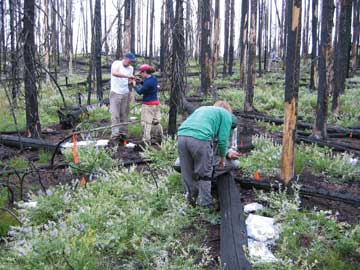|
NEWS NOTES — NEWS
Forest ecology
Yellowstone fires leave microbes nitrogen-hungry
 |
| Researchers returned to Yellowstone National Park in 2002 to collect soil data two years after the Glade Fire. Four years of monitoring the soil revealed sharp changes in soil nitrogen levels soon after a fire. Photograph is courtesy of Monica Turner. |
Researchers hot on the trail of severe fires in Yellow-stone National Park have found that the nitrogen in forest soils can be greatly affected by such fires, which occur within the region once every few hundred years, and kill most of a forest’s trees. Nature, however, has come up with a way to cope.
In 1988, Yellowstone National Park lost 36 percent of its forests to severe wildfires that ripped across the park, burning almost 7.4 million acres within park boundaries. The fires “ushered in a new level of attention on some of these natural big fires,” says Monica Turner, an ecologist at the University of Wisconsin-Madison. Turner and colleagues turned their attention to how nitrogen levels in forest soils changed in the years immediately following the fires. The findings could have implications for the growth of plants, which take up nitrogen as a main nutrient, as well as for the health of nearby streams, where excess nitrogen can accumulate as a pollutant that threatens the ecosystem.
Under fire-free conditions, microbes in forest soil take up organic nitrogen from items such as leaves and twigs, and convert it to an inorganic form available for other microbes and plants. Researchers have previously shown that after small wildfires in the eastern United States, when trees and plants are removed from the nitrogen cycle, excess inorganic nitrogen can be lost in runoff, often polluting nearby streams and watersheds. But Turner and colleagues, publishing March 20 in Proceedings of the National Academy of Sciences, set out to find out if the same is true within the less fertile soils of lodgepole pine forests of the western United States.
The team got their chance to take a close look at Yellowstone’s soil dynamics after fires once again struck the park again in 2000. Specifically, the team measured and calculated the various amounts of organic and inorganic nitrogen in 10 different stands of trees affected by the Glade and Moran fires of 2000, over a period of four years starting one year after the event. To better determine how nitrogen levels change within the time elapsed since a fire, they also incorporated nitrogen measurements from stands that burned 250 years ago, and again in 1988 and 2003.
The team found that, indeed, the nitrogen cycle differs for Western forests and Eastern forests in the years immediately following a fire. Instead of inorganic nitrogen leaching out of the system into rivers and streams, as occurs in the East, soil microbes in the West tend to hang on to nitrogen, consuming more than they produce.
The reason could be that microbes in Yellowstone, where there is not much nitrogen in the system to begin with, have developed a mechanism to conserve nitrogen, particularly in times of scarcity, such as after fire, Turner says. “We think it’s kind of cool that the system has mechanisms built in, in a sense, that help it retain something that’s low in availability but very important in the system,” she says.
Other researchers are not surprised that such a mechanism exists. “It’s not entirely new that microbial immobilization is a powerful mechanism, especially immediately after a fire,” says Timothy Fahey, a forest ecologist at Cornell University. But the Yellowstone fires represent an extreme case, Fahey says, and he would be interested to see if the microbial response is similar after less-severe disturbances.
Still, Turner says that the work is helping nail down specifics as to how forest ecosystems respond immediately following a fire. “And that’s becoming even more important as we think about global climate change,” she says, as projections for the Western United States indicate more frequent, large fires.

 Subscribe
Subscribe


